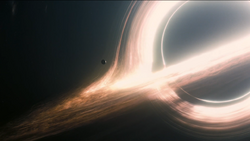Where Did the Water on Miller's Planet Come From

Miller's planet orbiting Gargantua
Miller's Planet is a planet and the first planet in the system orbiting Gargantua. Miller's Planet takes its name from Dr. Laura Miller, who landed on the planet and activated the "thumbs up" beacon. It is also the first location for the crew of the Endurance visit.
Contents
- 1 Backstory
- 2 Geography
- 3 Speculation
- 3.1 References
Backstory
Geography

Ranger 1 softly landing on Miller's planet.
Miller's planet is a waterworld, covered in a seemingly endless, shallow ocean. The planet's gravity is described to be "punishing" at 130% of Earth's, forcing human astronauts to move slowly and with some difficulty while on its surface. Time on the surface of Miller's planet passes very slowly relative to the time experienced by Romilly and that experienced on Earth. Romilly calculated that a single hour on Miller's Planet would equate to seven years back on Earth. Because of the planet's proximity to Gargantua, the immense gravity of the black hole causes the planet to be roiled by massive tidal waves as tall as 4,000 feet. There is no sign of dry land on Miller, which may not exist because of the sheer volume of water on the planet.
Dr. Amelia Brand describes the planet as "sterile" in accordance with the data findings of Dr. Laura Miller. The ocean was described to smell like distilled water poured on hot rocks - a mineral scent, but not like salt water. [1] The waves and shallow, sterile oceans would not support an environment capable of harboring advanced life (much less a civilization). It is also possible that the ocean's mineral content would fail to suit microbes and other simple lifeforms, despite the presence of necessary hydrocarbons, water, and starlight. A third reason for the term "sterile" may be that the planet simply did not exist long enough to develop life.
Speculation

A tidal wave approaching on Miller's planet.
- Despite the immense tidal wave, Doyle may have survived the encounter, but knocked unconscious, given that his spacesuit appeared undamaged. Even if a rescue team from Cooper Station were launched to Miller (and if the time dilation factor is exactly 1 hour per 7 years), around 9 hours would have passed for Doyle, but 64 years would've passed for everyone else. But if Doyle did survive and was rescued, he would suffer future shock given that it would have been a total of 65+ years that transpired while he was on Miller's planet. In a period of 9 hours, Doyle would certainly encounter many incoming waves before a rescue craft could find him, greatly reducing his chances for survival.
- One of the main reasons Miller's Planet isn't pulled into the black hole in spite of its proximity is that Kip Thorne made sure that Gargantua was a rapidly spinning black hole—and it turns out that the physics of rotating black holes differ from non-rotating ones. The sheer speed of Gargantua's rotation means there is a single stable orbit just outside of Gargantua's event horizon that is very stable. It was also stated, Miller's Planet to outside observers orbits Gargantua every 1.7 hours. On Miller's Planet, that means the planet orbits ten times a second around Gargantua , which is normally faster than the speed of light. But since the spin from Gargantua caused space to whirl around it similar to wind, Miller's Planet does not travel faster than light relative to its space as the laws of physics say you cannot travel faster than light relative to space, but space itself is not bound by the speed limit. As such, faster than light travel is possible by bending and twisting space. However, Gargantua would have to fill half the sky in order for it to be so close.
- The time dilation on Miller's Planet due to the gravitational forces of Gargantua would be tantamount to the planet moving through empty space at roughly 99.99999998% the speed of light.
- According to The Science of Interstellar by Kip Thorne, Miller's planet is shaped a little like a football, with one end constantly pointing at Gargantua. The waves are literally tidal waves, so it's not the waves coming toward you, it's the planet rotating under you and the fixed waves slamming into you. But because the planet doesn't rotate, the waves wouldn't slam into you. Fortunately, tidally locked planets can rock back and forth, and Thorne used this as a scientifically accurate loophole to explain tidal waves on a tidally locked planet. Also, because the water on Miller is mostly concentrated in the waves, you could have knee-high oceans, like the one shown in the film.
- It is possible that the wave that killed Laura Miller was the same wave that Cooper sees receding from the area on which they landed, because Brand mentioned that Miller probably died minutes before their arrival.
- The intense waves of Miller are comparable to tidal bores on Earth. This phenomenon occurs when the leading edge of tides of the ocean are powerful enough to roll against water currents on rivers and bays. Seeing ripples on Miller's planetary ocean moving in the opposite direction of the enormous waves is proof of a tidal bore. As with the Pororoca of the Amazon River, Miller's tidal bores have eroded any recognizable landmass on the planet.
References
- ↑ Interstellar, The Official Novelization, Ch. 19
Where Did the Water on Miller's Planet Come From
Source: https://interstellarfilm.fandom.com/wiki/Miller_%28planet%29
0 Response to "Where Did the Water on Miller's Planet Come From"
Post a Comment